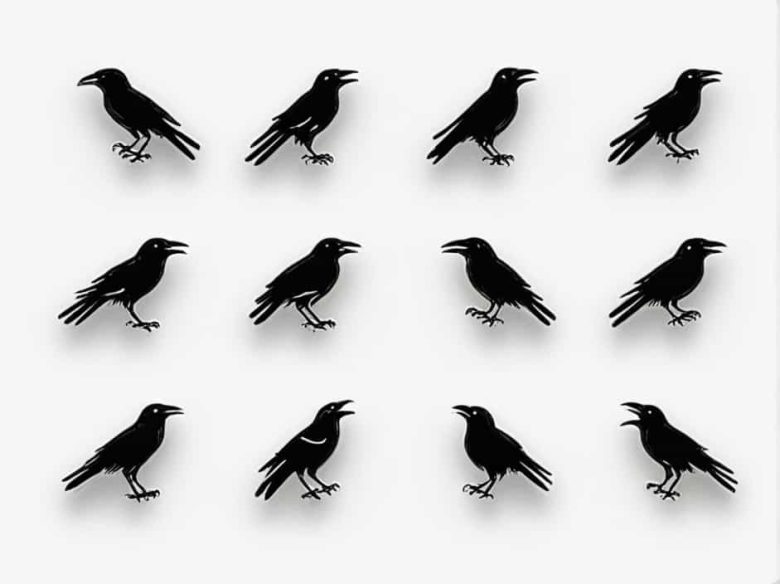Crows are among the most intelligent and social birds in the animal kingdom. One of their most mysterious and fascinating behaviors is gathering in large groups and loudly cawing. This behavior can seem eerie especially when hundreds of crows assemble in one place at dusk or make loud repetitive calls.
But why do crows do this? The reasons range from warning signals and social bonding to mourning rituals and territorial defense. In this topic we will explore the various reasons why crows gather and caw shedding light on their complex communication and social structure.
1. Why Do Crows Gather in Large Groups?
Crows are highly social and intelligent birds that rely on group interactions for survival. Here are some of the key reasons why they gather in large numbers:
A. Safety in Numbers
- Crows roost together in large flocks to protect themselves from predators such as owls and hawks.
- A large group makes it harder for predators to single out one bird.
- They often gather in urban areas or near bright lights which offer additional protection.
B. Communication and Information Sharing
- Crows use gatherings to exchange information about food sources and potential dangers.
- Some crows lead others to reliable food locations showing how they use social intelligence.
- Younger crows may learn survival skills from older more experienced members.
C. Mourning the Dead
- Crows are known to hold “funerals” when one of their own dies.
- They gather around a dead crow to investigate what happened and warn others of possible danger.
- Studies suggest that this behavior helps them identify threats and avoid similar dangers in the future.
D. Preparing for Roosting
- In the evening crows gather in large numbers before heading to their communal roosts.
- This pre-roosting behavior includes loud cawing socializing and even playing.
- Once it gets darker they settle into trees or other safe locations for the night.
2. Why Do Crows Caw So Loudly?
Crows are extremely vocal birds and their cawing serves many purposes. They use different types of calls depending on the situation.
A. Warning Calls
- Crows caw loudly to alert others of predators or threats in the area.
- If a hawk owl or even a human is seen as a danger they will gather and caw aggressively to drive it away.
- This behavior called “mobbing” involves multiple crows chasing and harassing a predator until it leaves.
B. Territorial Defense
- Crows are highly territorial and use loud caws to warn other crows to stay away from their nesting or feeding areas.
- If an intruding crow or rival flock enters their space they will engage in vocal confrontations to defend their area.
C. Mating and Social Interaction
- During the breeding season crows use specific calls to attract mates.
- They also engage in duets or coordinated calls to strengthen social bonds within their flock.
- Some cawing is simply part of playful or social interactions similar to how humans engage in conversation.
D. Summoning the Flock
- When one crow finds food it may call others to share the discovery.
- This ensures that the flock benefits from a good food source strengthening their cooperative nature.
3. Do Crows Recognize Each Other?
Yes crows have excellent memory and intelligence allowing them to recognize individuals within their group.
A. Identifying Friends and Family
- Crows live in tight-knit family groups and they remember their relatives for years.
- They use unique calls to identify specific members of their flock.
B. Recognizing Humans
- Crows can remember human faces especially those who have been kind or hostile to them.
- Studies have shown that crows can hold grudges for years and even teach other crows to recognize “dangerous” humans.
C. Teaching Younger Generations
- Older crows pass knowledge down to younger birds helping them avoid dangers or find good food sources.
4. The Role of Crows in the Ecosystem
Crows play an important role in maintaining ecological balance.
A. Cleaning Up Waste
- Crows are scavengers meaning they help clean up dead animals and food waste.
- This helps prevent the spread of disease and keeps the environment clean.
B. Controlling Insect Populations
- They eat insects pests and small rodents helping to control agricultural pests.
- This makes them beneficial to farmers and the natural ecosystem.
C. Spreading Seeds
- By eating fruits and then flying to different areas crows help disperse seeds contributing to plant growth and forest regeneration.
5. Are Crow Gatherings a Bad Omen?
Many cultures associate crows with bad luck death or supernatural events but this is simply folklore.
A. Myth vs. Reality
- In some cultures a gathering of crows is seen as a sign of misfortune.
- In reality their gathering is just a natural survival behavior.
- Some Native American tribes actually view crows as symbols of wisdom and guidance.
B. Why Do People Find Crows Mysterious?
- Their black feathers intelligence and vocal nature make them seem mysterious.
- Their tendency to gather around dead animals or at graveyards reinforces superstitions.
Despite myths crows are simply highly intelligent birds with complex social behaviors.
6. How to Respond to a Large Group of Crows?
If you see a large group of crows cawing loudly here’s what you can do:
A. Observe from a Distance
- Crows gathering in one place is usually not a cause for concern.
- Watch their behavior—they may be warning each other about a predator or preparing to roost.
B. Remove Food Sources
- If crows are gathering around your property they may be attracted to food scraps or garbage.
- Securing trash cans and avoiding feeding them can discourage large gatherings.
C. Respect Their Space
- Crows are highly intelligent and remember faces.
- If you try to scare them aggressively they may see you as a threat and return in greater numbers.
Crows gather and caw for many reasons including safety communication food sharing mourning and social bonding. Their vocal nature and intelligence make them one of the most fascinating birds in nature.
While some people find crow gatherings eerie they play a crucial role in ecosystems by controlling pests cleaning up waste and spreading seeds. Understanding their behavior helps us appreciate their intelligence and adaptability rather than fearing them.
So next time you hear a group of crows loudly cawing take a moment to observe—you might just witness an incredible display of avian communication and teamwork!



